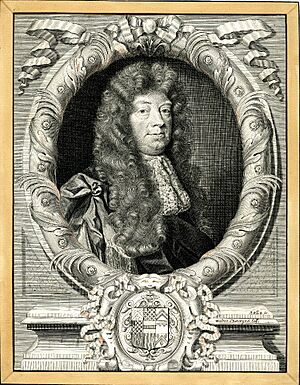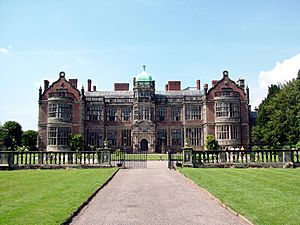Walter Chetwynd facts for kids
Walter Chetwynd (born May 1, 1633 – died March 21, 1693) was an important English gentleman from Ingestre Hall in Staffordshire. He was known as an antiquary, which means he loved studying old things and history. He was also a politician, meaning he was involved in the government.
Contents
Walter Chetwynd's Life
Walter Chetwynd was the only child of his father, also named Walter Chetwynd. His grandfather, who was also named Walter, built the famous Ingestre Hall.
In 1657, Walter Chetwynd studied law in London. But he soon returned to his home county of Staffordshire. There, he took on several important local jobs.
Becoming a Member of Parliament
In 1674, Walter Chetwynd was chosen to be a Member of Parliament for the town of Stafford. A Member of Parliament is someone elected to represent their area in the country's government. He lost his seat in 1679 but got it back in 1685.
During a time called the Popish Plot, he supported a man named Titus Oates. This was a period when people worried about plots against the king. Later, he shared information about the activities of the Duke of Monmouth in Staffordshire.
When King James II left the throne in what was called the Glorious Revolution, Walter was careful. He reported on troops moving through Staffordshire. He was elected again for Staffordshire in 1690. He even greeted King William III when he arrived in Lichfield.
A Historian of Staffordshire
Walter Chetwynd was also a very important historian for his home county. He started writing about Staffordshire in the 1660s and continued for the rest of his life. He was inspired by other famous historians who wrote about their counties.
In 1679, he began writing his book, "A Short Account of Staffordshire." However, by 1688, he had only finished writing about one part of the county. His work was not published until the early 1900s. The William Salt Archaeological Society published it in two parts.
His Many Interests
In 1678, Walter Chetwynd became a Fellow of the Royal Society. This is a group of very smart people who study science and improve knowledge. Even though he was a member, he didn't take part much in their meetings.
He likely knew Christopher Wren, a famous architect. Wren probably designed the new church at Ingestre, which was built between 1673 and 1676. Walter Chetwynd had many interests. He loved collecting old coins (called numismatics), reading books, studying religion, and mathematics. Most of all, he loved old things and nature.
He was very welcoming and friendly. He helped another scholar, Robert Plot, while Plot wrote his book about the natural history of Staffordshire.
Walter Chetwynd passed away in London in 1693 from a disease called smallpox. He was buried at Ingestre.
Walter Chetwynd's Family
On September 14, 1668, Walter Chetwynd married Anne Bagot. She was the daughter of Sir Edward Bagot. They had one daughter named Frances, but she sadly died when she was a baby. After Walter Chetwynd died, his estate at Ingestre went to his cousin, Walter Chetwynd.



